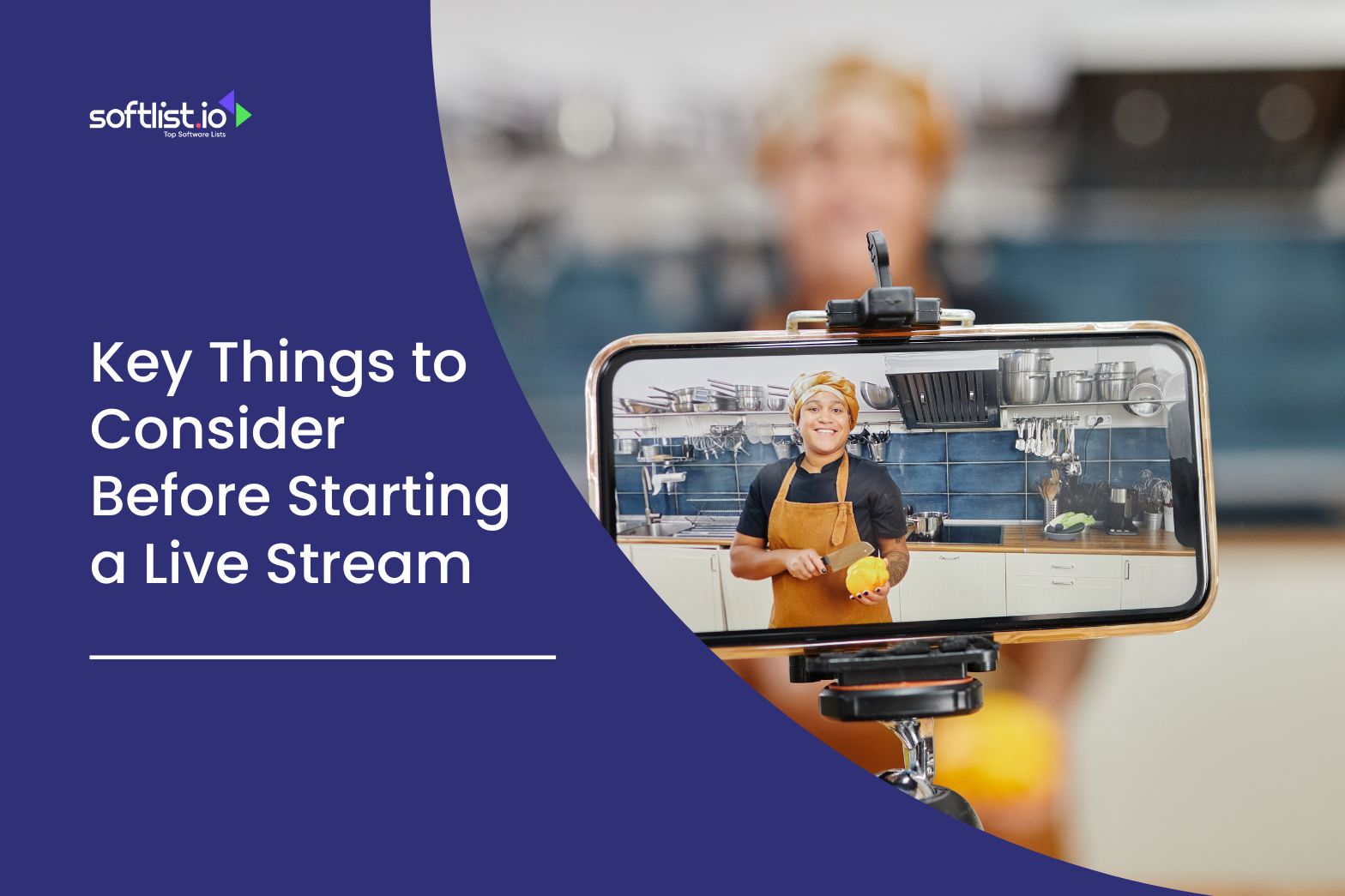Are you planning to start a livestream? It’s a great way to talk to people right now, whether you’re talking about business, teaching, or just having fun. Some important things need to be thought about before you press the “go live” button.
You will learn everything you need to know, from how to set clear goals to how to choose the right platform in this blog. Once you finish reading this, you’ll be ready to get the most out of your live streaming.
In the next section, we’ll talk about how to set goals and how those goals affect how you livestream.
Key Takeaways
Livestreaming offers a versatile and powerful way to connect with audiences, whether you’re engaging in a simple chat or hosting a complex, multi-user event.
Understanding the differences between terms like “live streaming” and “livestreaming” can help you communicate more clearly while leveraging the right tools and techniques will ensure your live streams are professional and effective.
- Choose the Right Term: Use “live streaming” or “livestreaming” consistently based on your audience and context.
- Collaborative Streaming: Utilize platforms like Zoom and multistreaming services to include multiple users in your livestreams and reach a broader audience.
- Technical Setup: Invest in the right equipment and ensure stable connections to avoid issues like lag or poor audio quality.
- Customization and Personalization: Use tools like overlays, encoders, and video players to customize your stream, making it more engaging and professional.
What is the Objective of Live Streaming?

Source: Canva Pro
Livestreaming is a powerful tool that allows creators, businesses, and individuals to connect with audiences in real-time. The primary objective of live streaming is to engage viewers by delivering content as it happens, offering a dynamic and interactive experience that pre-recorded videos cannot match.
Understanding the Purpose of Live Streaming
- Livestreaming allows creators to broadcast live video content to their audience, making them feel part of the action. Whether you’re hosting a live show, conducting a training session, or streaming gameplay, the goal is to foster real-time interaction with viewers.
- For businesses, the objective might be to increase brand awareness, launch new products, or engage with customers through live Q&A sessions.
Setting Clear Goals for Your Live Stream
- Before you go live, it’s essential to define your goals. Are you looking to increase viewership on your YouTube channel, grow your subscriber base, or boost engagement on social media platforms like Facebook Live or LinkedIn?
- Clear objectives will help guide your content, format, and delivery, ensuring that your live stream is focused and effective.
Why Do We Need Live Streaming?

Source: Canva Pro
Live streaming offers several unique benefits that make it an invaluable tool for both content creators and businesses. It’s not just about broadcasting; it’s about creating an interactive experience that can reach viewers across the globe instantly.
The Benefits of Live Streaming
- Real-Time Interaction: Live streaming allows for immediate engagement with your audience through features like live chat and real-time comments. This interaction can help build a strong community around your content.
- Wider Reach: Streaming platforms like YouTube, Twitch, and Facebook Live enable you to reach a global audience, breaking down geographical barriers. Whether it’s a live video streaming of a concert or a professional live training session, viewers can watch live from anywhere on any device.
- Cost-Effective Broadcasting: Compared to traditional live broadcasts, live streaming is more affordable. You can stream live video using just a mobile app, a browser, and an internet connection, making it accessible even for small creators.
Use Cases for Live Streaming
- Gaming and Esports: Platforms like Twitch have made live streaming synonymous with gaming. Streamers can showcase their gameplay, interact with viewers, and build a loyal following. This has also become a vital part of the esports industry, where live streaming allows fans to watch live competitions.
- Business and Marketing: Companies use live streaming to launch new products, host live shows, and conduct webinars. This not only engages the audience but also allows businesses to reach potential customers in real-time.
What is the Difference Between Live Broadcast and Live Streaming?

Source: Canva Pro
While both live broadcasting and live streaming involve delivering content in real-time, they differ significantly in terms of platform, audience engagement, and accessibility.
Traditional Live Broadcast vs. Modern Live Streaming
- Live Broadcast: Traditionally, live broadcasts refer to TV or radio transmissions where content is delivered in real-time but without the interactive features found in modern live streaming. These broadcasts are typically one-way, where viewers watch but do not interact.
- Live Streaming: Live streaming, on the other hand, is more interactive and accessible. Platforms like YouTube and Twitch allow streamers to engage directly with their audience through real-time chat and social media integration. This two-way interaction is a key differentiator between the two.
Advantages of Livestreaming Over Traditional Broadcast
- Interactivity: Livestreaming platforms enable features like chat, live polls, and real-time viewer feedback, creating a more engaging experience. This interactivity is something traditional live broadcasts cannot offer.
- Accessibility and Flexibility: Unlike live broadcasts that require specialized equipment and broadcast rights, live streaming can be done using a mobile app or a computer. It’s accessible to anyone with an internet connection, making it a flexible option for creators and businesses of all sizes.
Understanding the objectives, benefits, and differences between live streaming and traditional live broadcasts can help you make the most of your live video efforts, whether you’re aiming to engage an audience on social media or launch a new product to a global market.
Is It Live Streaming or Livestreaming?

Source: Canva Pro
The terms “live streaming” and “livestreaming” are often used interchangeably, but understanding the nuances between them can help you communicate more effectively, especially when engaging with a broad audience.
Understanding the Terminology
- The term “live streaming” refers to the process of broadcasting video or audio content in real-time over the Internet. This term emphasizes the “live” aspect, which is crucial for conveying the immediacy of the content.
- “Livestreaming,” often written as one word, is more commonly used in the tech industry and among platforms. It has become a catch-all term to describe both the process and the services that enable it, such as livestreaming platforms like YouTube or Twitch.
Consistency in Usage
- When choosing between “live streaming” and “livestreaming,” consistency is key. For formal communication, such as marketing or professional documents, using “live streaming” may be clearer and more accessible to a general audience.
In contrast, “livestreaming” can be used when referring to specific services or platforms, where the term is widely recognized.
How Do I Live Stream with Others?
Collaborative live streaming is an excellent way to enhance your content by featuring guest speakers, co-hosts, or even multiple users in different locations. There are several tools and techniques you can use to make this process seamless and engaging.
Collaborating on a Live Stream
- Use Collaborative Tools: Platforms like Zoom, Skype, and specialized livestreaming services offer features that allow multiple users to participate in a single live stream. These tools often include screen sharing, video conferencing, and the ability to invite guests to your livestream.
- Multistreaming Across Platforms: To reach a wider audience, you can multistream your content across multiple platforms simultaneously. Services like Restream allow you to broadcast on YouTube, Facebook, and Twitch all at once, enabling you to engage with viewers across different platforms in real time.
Technical Considerations for Seamless Streaming
- Ensure Stable Connections: For a smooth collaborative live stream, all participants need a stable internet connection. This helps to minimize latency and lag, ensuring that the conversation remains fluid and engaging for viewers.
- Use the Right Equipment: Depending on the complexity of your stream, you might need additional equipment such as an encoder to manage video or audio quality, overlays to personalize your stream, and multiple cameras to capture different angles.
Ensuring that your setup is well-configured will help you avoid common technical issues like lag and poor audio synchronization.
Final Thoughts
Livestreaming has become an essential tool for content creators, businesses, and individuals looking to connect with audiences in real time. Whether you’re streaming a video game, hosting a webinar, or broadcasting sporting events, the right streaming service and solutions can make all the difference.
With the ability to seamlessly upload and distribute content across streaming platforms, live streaming allows for engaging and interactive experiences. Using features like HTML5 video, concurrent streams, and on-demand viewing options, you can customize your livestreams to meet the needs of users worldwide.
As more viewers browse content on smartphones and web browsers, it’s crucial to ensure your streaming app is optimized for various devices, including Android. Remember to embed logos, video files, and other personalized elements to enhance your brand presence during livestreams.
Enhance your livestream content. Explore Softlist’s ‘Content Creation‘ category for tools that help you create compelling and engaging live content effortlessly.
FAQs
How Do I Optimize my Livestream for Different Devices?
Ensure your streaming app is compatible with both Android and web browsers, and use HTML5 video for seamless viewing across devices.
Can I Monetize my Live Streams?
Yes, you can monetize through subscriptions, ads, and on-demand content, particularly in niches like video games and e-commerce.
What Should I Do if I Experience Lag During a Live Stream?
Check your backend setup, optimize your connection, and use a reliable streaming service to minimize lag.
How Can I Embed My Logo in a Live Stream?
Most streaming platforms allow you to upload and embed your logo directly into the video stream.
What are the Best Ways to Distribute Livestreams?
Use concurrent streams across multiple platforms and offer on-demand viewing to maximize reach.






